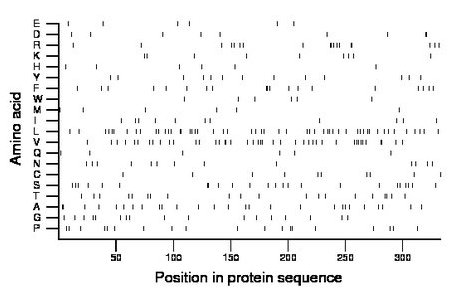
| Name: NPBWR2 | Sequence: fasta or formatted (333aa) | NCBI GI: 30581164 | |
|
Description: neuropeptides B/W receptor 2
|
Referenced in: Peptide and Protein G-coupled Signals
| ||
|
Composition:

Amino acid Percentage Count Longest homopolymer A alanine 8.1 27 2 C cysteine 3.0 10 1 D aspartate 2.7 9 2 E glutamate 1.8 6 1 F phenylalanine 5.7 19 2 G glycine 5.1 17 1 H histidine 1.8 6 1 I isoleucine 3.3 11 1 K lysine 2.7 9 1 L leucine 15.6 52 2 M methionine 1.8 6 1 N asparagine 3.9 13 1 P proline 5.7 19 1 Q glutamine 1.8 6 1 R arginine 5.4 18 2 S serine 7.2 24 2 T threonine 6.0 20 2 V valine 12.6 42 2 W tryptophan 1.8 6 1 Y tyrosine 3.9 13 1 |
Comparative genomics:
Search single species RefSeq proteins at NCBI
Search summary 
Figure data | ||
Related human proteins:Protein Relative score Description Self-match 1.000 neuropeptides B/W receptor 2 NPBWR1 0.570 G protein-coupled receptor 7 SSTR2 0.346 somatostatin receptor 2 OPRD1 0.340 opioid receptor, delta 1 SSTR5 0.335 somatostatin receptor 5 SSTR1 0.329 somatostatin receptor 1 SSTR3 0.325 somatostatin receptor 3 OPRM1 0.320 opioid receptor, mu 1 isoform MOR-1H OPRM1 0.320 opioid receptor, mu 1 isoform MOR-1 OPRM1 0.320 opioid receptor, mu 1 isoform MOR-1B5 OPRM1 0.320 opioid receptor, mu 1 isoform MOR-1B2 OPRM1 0.320 opioid receptor, mu 1 isoform MOR-1B3 OPRM1 0.320 opioid receptor, mu 1 isoform MOR-1B1 OPRM1 0.320 opioid receptor, mu 1 isoform MOR-1A OPRM1 0.320 opioid receptor, mu 1 isoform MOR-1B4 OPRM1 0.320 opioid receptor, mu 1 isoform MOR-1O OPRM1 0.320 opioid receptor, mu 1 isoform MOR-1X OPRK1 0.318 opioid receptor, kappa 1 SSTR4 0.311 somatostatin receptor 4 OPRL1 0.292 opiate receptor-like 1 OPRL1 0.292 opiate receptor-like 1 OPRM1 0.283 opioid receptor, mu 1 isoform MOR-1G2 OPRM1 0.280 opioid receptor, mu 1 isoform MOR-1G1 OPRM1 0.280 opioid receptor, mu 1 isoform MOR1-K1 GALR2 0.197 galanin receptor 2 MCHR1 0.194 G protein-coupled receptor 24 GALR1 0.188 galanin receptor 1 KISS1R 0.180 G protein-coupled receptor 54 CXCR3 0.179 chemokine (C-X-C motif) receptor 3 isoform B CXCR3 0.179 chemokine (C-X-C motif) receptor 3 isoform AHuman BLASTP results (used to prepare the table) | |||
Gene descriptions are from NCBI RefSeq. Search results were obtained with NCBI BLAST and RefSeq entries. When identical proteins are present, the self-match may not be listed first in BLASTP output. In such cases, the table above has been reordered to place it first.
See About the Figures for the scoring system used in the figure above right. The same scoring system was used in the table of BLASTP results.
Guide to the Human Genome
Copyright © 2010 by Stewart Scherer. All rights reserved.
